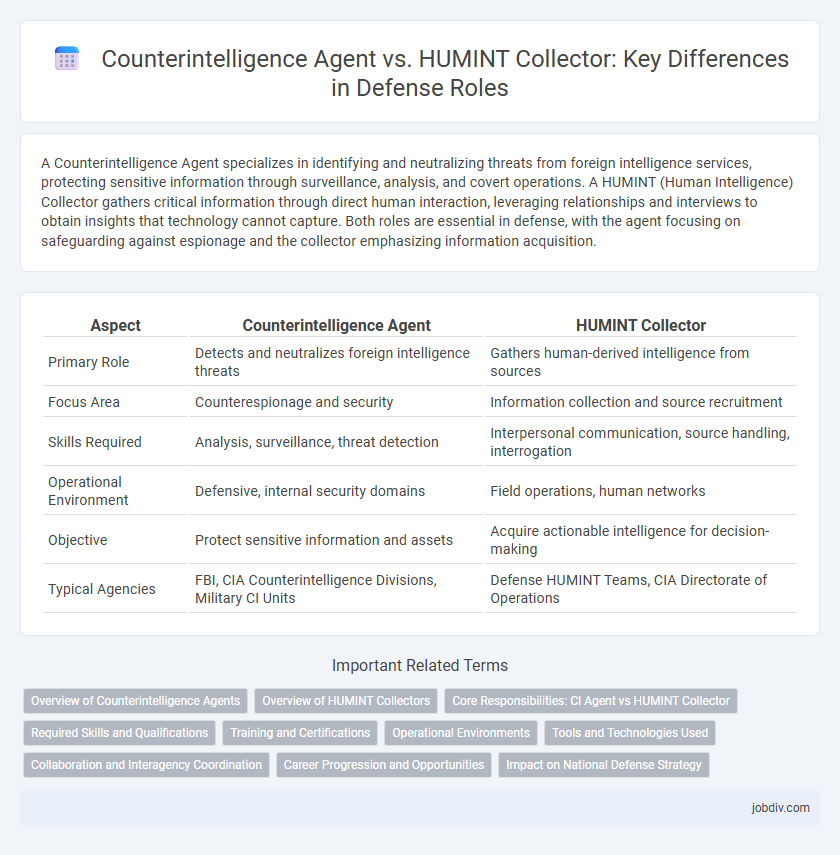A Counterintelligence Agent specializes in identifying and neutralizing threats from foreign intelligence services, protecting sensitive information through surveillance, analysis, and covert operations. A HUMINT (Human Intelligence) Collector gathers critical information through direct human interaction, leveraging relationships and interviews to obtain insights that technology cannot capture. Both roles are essential in defense, with the agent focusing on safeguarding against espionage and the collector emphasizing information acquisition.
Table of Comparison
| Aspect | Counterintelligence Agent | HUMINT Collector |
|---|---|---|
| Primary Role | Detects and neutralizes foreign intelligence threats | Gathers human-derived intelligence from sources |
| Focus Area | Counterespionage and security | Information collection and source recruitment |
| Skills Required | Analysis, surveillance, threat detection | Interpersonal communication, source handling, interrogation |
| Operational Environment | Defensive, internal security domains | Field operations, human networks |
| Objective | Protect sensitive information and assets | Acquire actionable intelligence for decision-making |
| Typical Agencies | FBI, CIA Counterintelligence Divisions, Military CI Units | Defense HUMINT Teams, CIA Directorate of Operations |
Overview of Counterintelligence Agents
Counterintelligence agents specialize in identifying and neutralizing threats posed by foreign intelligence services, safeguarding sensitive national security information from espionage and sabotage. They employ advanced surveillance techniques, conduct background investigations, and analyze intelligence reports to detect insider threats and prevent infiltration. Unlike HUMINT collectors who gather human intelligence, counterintelligence agents focus on protecting assets and operations from compromise.
Overview of HUMINT Collectors
HUMINT Collectors specialize in gathering human intelligence through direct interaction, including interviews, surveillance, and interrogations to acquire vital information on adversaries' capabilities and intentions. Unlike Counterintelligence Agents who focus on detecting and neutralizing espionage threats, HUMINT Collectors emphasize source development and recruitment within hostile or sensitive environments. Their operations are critical for obtaining actionable intelligence that supports strategic decision-making and military operations.
Core Responsibilities: CI Agent vs HUMINT Collector
Counterintelligence agents are primarily responsible for identifying, deterring, and neutralizing threats posed by foreign intelligence services, safeguarding sensitive information from espionage and insider threats. HUMINT collectors specialize in gathering human intelligence through interpersonal contact, recruitment, and debriefing of sources to provide actionable information on adversary capabilities and intentions. Both roles require rigorous operational security but differ in focus; counterintelligence agents emphasize protection and detection, while HUMINT collectors concentrate on information acquisition and source development.
Required Skills and Qualifications
Counterintelligence agents require expertise in threat analysis, counterespionage tactics, and proficiency in surveillance technologies to identify and neutralize hostile intelligence activities. HUMINT collectors must excel in interpersonal communication, cultural awareness, and clandestine source recruitment to effectively gather human intelligence. Both roles demand strong analytical skills and security clearances, but counterintelligence agents focus more on defensive operations while HUMINT collectors emphasize intelligence acquisition.
Training and Certifications
Counterintelligence agents require specialized training in identifying and neutralizing threats posed by foreign intelligence services, including rigorous coursework in surveillance detection, cybersecurity, and threat analysis, often backed by certifications such as the Certified Information Systems Security Professional (CISSP) and the Counterintelligence Special Agent Training Program. HUMINT collectors undergo extensive instruction in human source operations, interrogation techniques, and cultural and language proficiency, frequently supported by certifications like the Defense Language Proficiency Test (DLPT) and the Human Intelligence Collector Course. Both roles demand continuous education in emerging intelligence methodologies and adherence to national security protocols to maintain operational readiness and effectiveness.
Operational Environments
Counterintelligence agents operate primarily in hostile or adversarial operational environments, focusing on identifying, preventing, and neutralizing espionage threats within military or governmental contexts. HUMINT collectors function across diverse operational settings, including hostile, permissive, and uncertain environments, gathering human intelligence through direct interaction and covert operations. The distinct operational environments shape the methodologies and risk levels for counterintelligence agents versus HUMINT collectors in defense missions.
Tools and Technologies Used
Counterintelligence agents utilize advanced surveillance systems, encryption technologies, and cyber defense tools to detect and neutralize espionage threats, ensuring protection against foreign intelligence activities. HUMINT collectors employ field-based communication devices, covert recording equipment, and biometric identification tools to gather human-sourced intelligence critical for operational insights. Both roles integrate cutting-edge software for data analysis and secure information exchange, enhancing strategic decision-making in defense intelligence operations.
Collaboration and Interagency Coordination
Counterintelligence agents and HUMINT collectors collaborate closely to identify and neutralize foreign intelligence threats, leveraging HUMINT's human source intelligence with counterintelligence's threat analysis expertise. Effective interagency coordination ensures seamless information sharing between agencies such as the FBI, CIA, and NSA, enhancing operational efficiency and national security. Joint training exercises and integrated communication platforms further strengthen their partnership in addressing espionage and insider threat vulnerabilities.
Career Progression and Opportunities
Counterintelligence agents specialize in detecting and preventing espionage, offering career advancement through roles in federal agencies like the FBI, CIA, and military intelligence with opportunities to lead security operations or manage counterintelligence units. HUMINT collectors gather human intelligence by recruiting and handling sources, progressing through field assignments toward senior analyst positions or strategic intelligence roles within organizations such as the Defense Intelligence Agency and National Security Agency. Both career paths demand continuous training in intelligence tactics, with counterintelligence roles emphasizing threat analysis and HUMINT focusing on interpersonal skills and source management.
Impact on National Defense Strategy
Counterintelligence agents disrupt adversarial intelligence efforts by identifying and neutralizing insider threats, directly safeguarding critical national defense secrets and assets. HUMINT collectors gather human-sourced intelligence that provides actionable insights into enemy intentions and capabilities, enhancing strategic decision-making at the highest defense levels. Together, their complementary roles strengthen the integrity and effectiveness of a nation's defense strategy by ensuring both protection and proactive intelligence.
Counterintelligence Agent vs HUMINT Collector Infographic

 jobdiv.com
jobdiv.com